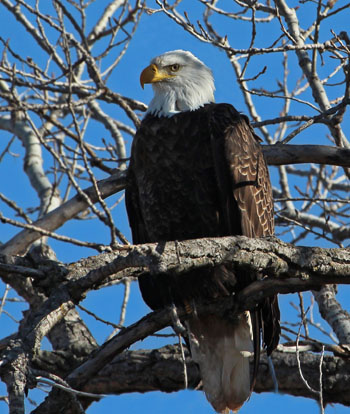
The Bald Eagle (Haliaeetus leucocephalus) is unquestionably a stately bird. It became the National Emblem of the U. S. in 1782. Benjamin Franklin had wanted the Wild Turkey as the national symbol, but this was one debate he did not win.
Dr. G. M. Sutton, in his book, “Oklahoma Birds” (1967), said that the Bald Eagle “[m]ay have nested formerly in Cimarron County…and along Arkansas River in Osage County, but no recent summer records for either of these areas…” Thus Sutton considered it only as a wintering species in Oklahoma in 1967. Sutton said the Oklahoma specimens at hand were of the southern (smaller) race of the species. The Bald Eagle is a good example of the rule that far northern races of species tend to be larger than southern races; this rule has to do with preservation of heat—a larger body has a smaller percentage of body surface to body weight and can therefore preserve heat better.
Much has changed since Dr. Sutton wrote his book in 1967. The George Miksch Sutton Avian Research Center, in Bartlesville, initiated a program in the 1980’s to introduce nesting birds into the state. The Sutton Center began by taking eggs early in the nesting season from Bald Eagle nests in Florida; most of the eagle pairs from whom eggs were taken, laid another clutch of eggs, so any damage to the Florida population appeared to be minimal. The gathered eagle eggs were carefully incubated to hatching, the young then fed using eagle hand puppets as surrogate parents; ultimately these young were fledged into the wild in 5 different southern states, I believe it was, including Oklahoma. Now there are at least 80 active Bald Eagle nests in Oklahoma. In 2007 the Bald Eagle was removed from Endangered and Threatened Species List. You can view an active Bald Eagle nest at http://www.suttoncenter.org/pages/live, then click on “Live Bald Eagle Nest Camera, watch now” at the top of the Sutton Page. You will actually see 2 nests! This opportunity is made possible by the Sutton Center.
Bald Eagles usually lay 2 eggs in a huge nest that can be 10 feet tall and 6 feet across. For several years, until a year or 2 ago, there was a Bald Eagle pair nesting at Wes Watkins Reservoir in eastern Oklahoma County and western Pottawatomie County; I have heard that the eagle nest tree there finally blew down, and a rumor that the eagle pair may now be nesting at OG&E’s Horseshoe Lake, near Harrah in eastern Oklahoma County, so keep a look-out when you travel in that area.
The Bald Eagle often feeds on fish, frequently dead ones, so it is something of a scavenger. It also will feed on ducks. For all its regalness, however, it is not as fierce a predator as the Golden Eagle. Dr. Jim Lish, who recently gave a talk to our club about the various plumages of the Red-tailed Hawk, once followed a Bald Eagle all day in eastern Oklahoma. He saw the bird leave its roost in the morning; it flew to a perch at the river (I do not know just how far this was) where it stayed until noon, then it flew to another perch, and at the end of the day flew back to the roost. I do not think Jim followed up his research on a second day!
We were fortunate to find 2 adults on our 2011 Oklahoma City Christmas Bird Count, 1 at Lake Overholser and 1 at Lake Hefner: we have seen at least 1 on our count for the last several years. The best time of year to see the Bald Eagle on our local reservoirs is when the lakes are mostly iced over in winter. Then usually you can find one standing on the ice near any open water on the lakes where the ducks gather, likely waiting for the next duck that weakens due to hunger or freezes up in the ice. Perhaps 1 day we will have a nesting pair near 1 of our large reservoirs.
